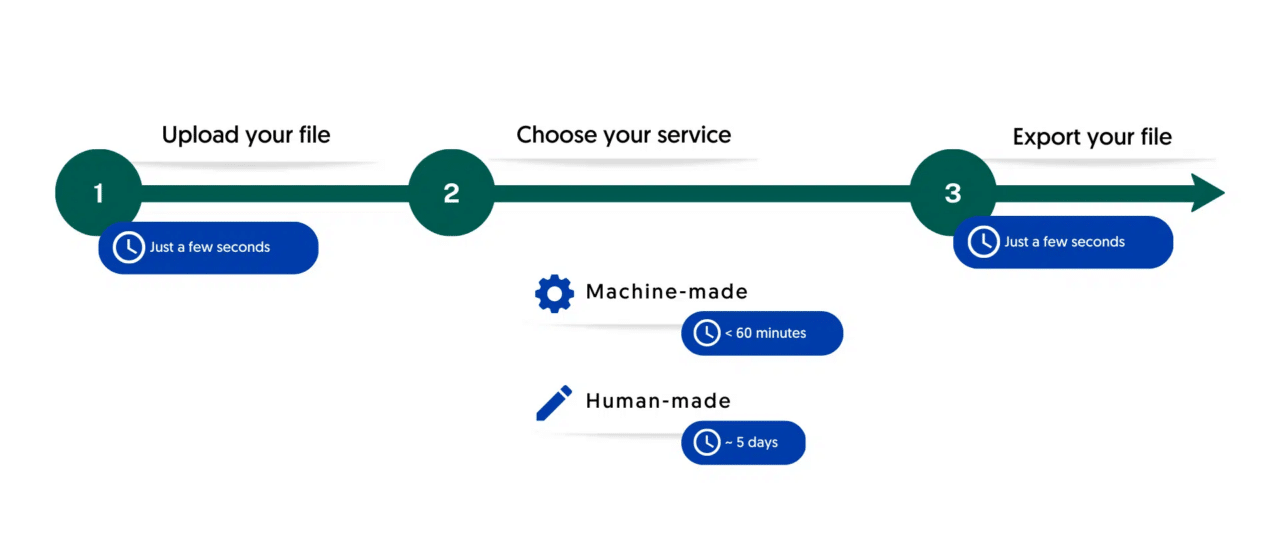Transcription is an essential part of the journalism process. It involves taking spoken words, converting them to written form and preserving the original meaning and intention. Transcription provides a permanent record that journalists can refer back to in order to accurately source information or capture quotes for articles and reports. By using easy-to-use transcription tools, reporters can quickly and efficiently transcribe recordings for use in their stories without having to invest in expensive software or equipment. In this blog post, we will explore some essential transcribing tips for reporters along with a few recommended easy-to-use tools that can make the job easier.
Table of Contents
Choosing the Right Transcription Tool
Having the right transcription tool is essential for successful transcribing. It is important to look for reliable transcription services that offer high-quality results and a range of features such as timed transcripts, automated speech recognition, and multiple languages. This will ensure that you can accurately capture and document all relevant information from your recordings with minimal effort. With the right transcription service, you can be sure that your transcripts are accurate enough to use in articles or reports.
Comparing different transcription tools and their features
When choosing a transcription tool, it is important to compare different options and their features so that you can find the best one for your needs. Not all transcription tools offer the same features, so it is important to look for services that provide automated speech recognition, multiple language support, and timed transcripts. Some services may offer other useful features such as audio-editing capabilities or integrations with other software. By researching and comparing different transcription tools, you can make sure that you choose the one that provides the right balance of price and features for your specific needs.
Amberscript: a leading supplier for automated and professional transcription
Among the best transcription tools out there is Amberscript. This powerful service offers both automated and professional transcription services with features such as multi-language support, automated speech recognition, and timed transcripts that make it a great choice for both experienced reporters and those new to using transcription tools. What’s more, Amberscript has an easy to use interface along with helpful customer support that provides assistance when needed. Amberscript offers competitive pricing plans allowing users to pay only for what they need, making it one of the most cost effective options on the market. With all these features combined, Amberscript makes transcribing recordings fast and simple for even the busiest reporters.

Get a customized offer
Request a quote for your transcription needs
Preparing for Transcription
Recording High-Quality Audio
Before beginning the transcription process, it is important to ensure that you have high-quality audio recordings. Poor audio quality can make transcribing difficult and time consuming so it is essential to make sure that your source recordings are as clear as possible. It’s also helpful to record in a quiet environment with minimal background noise. This will help reduce the amount of noise interference present in your recordings and make them easier to transcribe.
Minimizing Background Noise and Disruptions
In order to produce the best results from a transcription tool, it is important to minimize background noise and disruptions during recordings. This can be done by using a microphone with good noise cancellation capabilities or by setting up the recording in a quiet room with minimal sound interference. By minimizing distractions during recordings, reporters can ensure that their source material is as clear as possible, which will make the job of automatically transcribing audio easier for tools such as Amberscript. Additionally, this will also help produce more accurate transcripts from manual transcription services like those offered by Amberscript.
Using Suitable Recording Equipment and Microphones
Using the right recording equipment and microphones can also help minimize background noise and ensure high-quality recordings. It is important to look for equipment that has good noise cancellation capabilities as well as a microphone that is suitable for the environment you are recording in. Additionally, some microphones may be better suited for transcribing certain types of voices or accents than others, so it is important to consider these factors when making your selection. By using equipment and microphones that are optimized for transcription, reporters can make sure that their recordings will be clear enough to transcribe accurately and quickly.
Tips for Efficient Transcription
Breaking Audio Into Smaller Segments for Better Accuracy
One of the best tips for efficient transcription is to break audio into smaller segments. This can help improve accuracy and save time by reducing the amount of material that needs to be transcribed at once. Additionally, by breaking the audio up into shorter chunks, it is easier to review and make corrections if needed. However, when using a professional transcription tool such as Amberscript, this step is not necessary as automated speech recognition technology can quickly and accurately transcribe long recordings without having to manually break them down.
Understanding the Transcription Tool’s Features and Shortcuts
It is also important to understand the features and shortcuts offered by your transcription tool. Most transcription tools offer a range of options such as automated speech recognition, timed transcripts, and audio editing capabilities. Taking some time to learn about these features can help you take advantage of them and speed up the transcription process. Many of these tools offer helpful keyboard shortcuts so it’s worth spending some time getting familiar with them in order to make transcribing easier and more efficient. For example, Amberscript offers an array of features such as multi-language support, audio editing capabilities, and timed transcripts to make the transcription process easier. What’s more, Amberscript also provides helpful keyboard shortcuts and a user-friendly interface that makes it simple for even beginners to take advantage of its powerful features. With all of these features combined, Amberscript is one of the most efficient and reliable transcription tools available today.
Leveraging Custom Dictionaries for Industry-Specific Terms
Leveraging custom dictionaries for industry-specific terms is a great way to quickly and accurately transcribe material in a specific field. Amberscript gives reporters the ability to add their own personalized glossary which contains words or phrases that are regularly used in their particular line of work. This can help make the transcription process faster while ensuring that all of the important details are captured correctly. Using a custom dictionary also allows you to use alternate spellings or terms that may not be commonly understood. By taking advantage of these features, reporters can save time and produce accurate transcripts with ease.
Ensuring Accuracy in Transcription
Reviewing and Editing Automated Transcripts
One key step to ensuring accuracy in transcription is to review and edit automated transcripts. While automated transcripts can be helpful for quickly getting a rough draft of the material, it’s important to go through them manually and make any necessary corrections or adjustments. This process can take some time but is essential for making sure that your transcriptions are accurate and complete.
For extra precise transcriptions, manual transcriptions are a great option. With manual transcription, an experienced typist will go through the recording and produce a high-quality, accurate transcript. Amberscript offers experienced professional typists who can help with this process and ensure that your transcriptions are of the highest quality possible.
How to Transcribe With Amberscript

Implementing Speaker Identification in Multi-Participant Conversations
When transcribing multi-participant conversations, it is essential to implement speaker identification in order to ensure accuracy. Amberscript offers automated speaker distinction which can make this process simpler and more efficient. Additionally, providing context for each conversation such as noting the locations of the participants or other relevant information will help ensure that your transcriptions are accurate and easy to follow. By taking advantage of these features, reporters can quickly produce high-quality transcripts with ease.
Timestamping for Easy Reference to Specific Sections
Timestamping is a key tool for ensuring accuracy in transcription. Amberscript adds timestamps automatically at various points throughout the recording which can make it much easier to quickly reference and locate sections of audio as needed. This can be helpful for reporters who may need to go back and review portions of recordings or revisit certain topics, saving time while producing accurate transcriptions that are easy to follow. Finally, it’s important not to rush through the transcription process and take your time to ensure accuracy. With patience and following the tips above, you will find that the transcription process is much more efficient while providing high-quality results.
Data Security and Privacy
Data security and privacy are essential when it comes to transcription. With sensitive information such as personal details or confidential business documents being transcribed, it’s important to take stringent measures to ensure that the data remains secure. This can include using strong passwords for access control, deploying encryption techniques, and ensuring that only authorized personnel have access to the recordings and transcripts. Taking these steps will help protect confidential information and keep it out of the wrong hands.
Ensuring the transcription tool complies with privacy regulations
When selecting a transcription tool, it’s essential to ensure that the tool complies with privacy regulations. Amberscript is GDPR compliant, meaning any data stored or processed through their services is secure and safe. By taking the time to research your transcription tool and understand its security protocols, you can guarantee that confidential information remains protected during the transcription process.
Finalizing Transcriptions
Finally, it’s important to thoroughly proofread and verify transcriptions before they are finalized. This is especially true when dealing with sensitive information or legal documents that require accuracy in order to be valid. Taking the time to review transcripts can help catch any errors or discrepancies that may have been missed during the initial transcription process. Many tools offer features such as integrated spell-checkers and auto-correction capabilities which can help ensure accurate results. By double-checking your work and using these helpful features, you can make sure all transcripts are accurate prior to finalization. By taking the time to properly prepare for the transcription process, leverage helpful tools and features, and thoroughly check each transcription before it’s finalized, you can save time and ensure accurate results each and every time. With Amberscript, you can edit your transcript in the editor yourself or you can outsource the task to their experienced professionals who can help ensure accuracy and quality. Following these tips will help you make the most out of your transcription experience.
Exporting Transcriptions in Different Formats
Once a transcription is finalized, it can then be exported in different formats depending on the needs of the user. Many tools offer ways to export transcripts as PDF files, audio clips, or other document types for easy distribution and sharing. Additionally, some tools provide integration with third-party programs which allow users to export transcriptions directly into their existing workflows. By taking advantage of these features, you can quickly and easily share your completed transcriptions with clients or colleagues in just a few clicks.
Integrating transcribed content into reporting workflow
Transcribed content can be integrated into a reporting workflow for easy access and analysis. Many transcription tools offer ways to export data in a variety of formats, such as CSV or JSON, that can then be used with third-party programs. This allows users to quickly import large amounts of data into their existing workflows, saving time and effort in the process. Some programs also provide features such as searchable transcripts which can help locate specific information more easily. With these features at your disposal, you will have all the necessary tools to make the most out of your transcription experience and ensure accurate results every time!
Recap of Essential Transcribing Tips for Reporters
In conclusion, Amberscript is the perfect tool for any reporter who wants to streamline their journalism workflow. With its easy-to-use features and comprehensive capability, Amberscript can help save time and ensure accurate results every time. By taking the time to properly prepare for your transcription task, leveraging helpful tools and features provided by Amberscript, and thoroughly proofreading each transcript before finalization, you can make sure all transcripts are accurate prior to finalization. Additionally, utilizing easy-to-use transcription tools like Amberscript will allow reporters to better manage their workflows while also streamlining reporting processes. So don’t hesitate – take advantage of all that Amberscript has to offer and make the most out of your transcription experience today! With these essential tips in mind, reporters can remain competitive in today’s ever-evolving media landscape.
Transcribe audio to text without errors and receive a perfect export.
Audio transcription has never been this simple. Start now and save hours of time!
Your audio files are confidentially stored in a secure environment.

